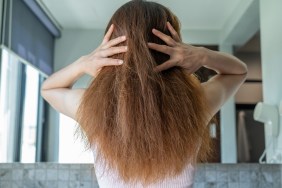In the hot, muggy summer months, it can be a challenge for textured-haired gals to achieve silky, swingy, frizz-free straight hair. Blowouts simply won’t cut it (humidity ensures they don’t last longer than a few hours). Chemical straighteners like relaxers can help keep fuzz at bay and permanently smooth and straighten coily, curly or wavy hair. Relaxers straighten the hair by breaking the disulfide bonds within the strands, allowing them to be physically manipulated and rearranged. The chemical straightener lasts until your hair grows out, but it can be very damaging.
Choose the right type of relaxer
There are three types of relaxers; sodium hydroxide, calcium hydroxide and ammonium thioglycolate. Sodium hydroxide relaxers are commonly called lye relaxers. Lye relaxers can be used on wavy, curly or coily hair. No-lye relaxers, aka calcium hydroxide relaxers, are designed for sensitive scalps and can also be used on curly, coily or wavy textures. They are, however, actually harsher to the hair than lye relaxers and can dry the hair out. Ammonium thioglycolate isn’t recommended for use on very coarse or coily hair (the formula isn’t strong enough to straighten it), but it’s great for straightening fine, curly or wavy hair.
Choose a relaxer strength compatible with your hair type. “The amount of active chemical determines the strength. Mild is good for fine, color-treated or damaged hair. Regular strength is for normal hair. Super strength is marketed toward very thick, coarse hair,” explains celebrity hairstylist Carla Gentry Osorio, whose star clientele includes Jada Pinkett Smith, Kerry Washington and Alicia Quarles. “However, I don’t recommend using super on any hair type because it causes breakage due to the high amount of the active chemical ingredient in the formulation.” Regular strength is usually sufficient for very thick, coarse hair.
Ladies with severely damaged or bleached hair should avoid relaxing their hair altogether. “It is never a good idea to relax and color your hair at the same time. To lift color, ammonia and peroxide are involved. This will lead to severe breakage,” cautions Osorio. Stick to safer alternatives, such as temporary rinses or semi-permanent colors that darken or cover grays instead. Hennas should be avoided as well, since they are very drying on the hair. “Women taking certain medications for thyroid concerns or high blood pressure should also consult with their physician since the medication can have an adverse effect on how their hair reacts to the chemical procedure,” adds celebrity hairstylist Amoy Pitters.
Prepping for your treatment
Pitters advises against shampooing your mane or scratching your scalp in the days leading up to the relaxer process to avoid scalp burns and irritations. “You should not aggravate the scalp in any way. When brushing or combing your hair before and during the process, avoid contact with the scalp since these actions can scrape it and leave it open to chemical injuries,” adds Osorio.
Ideally, a professional hairstylist should apply relaxers. If you still insist on relaxing your own hair at home, however, be sure to take the necessary precautions. Read the instructions on the box carefully, wear gloves when handling the relaxer, use a color-sensitive neutralizer that alerts you when the relaxer has been thoroughly removed and enlist the aid of an experienced friend to help you apply the relaxer to the back of your head.
The relaxing process
Basing the scalp with a light coat of petroleum jelly acts as a barrier and is often recommended to protect the scalp from chemical burns. “When applying relaxer for the first time to virgin hair, the relaxer should be applied to the ends first working your way up the roots, smoothing the strands in the process. The ends take longer to process, whereas the roots respond faster because of the heat of your body,” says Pitters.
Hair should never be relaxed bone straight. This can cause the hair to look limp and lifeless. Plus, over time the over-relaxed hair may thin out. Instead, aim to relax hair relatively straight, leaving in a tiny bit of texture to give the hair some bounce.
Be sure to work quickly and carefully within the processing time for your chosen relaxer. Ten to 15 minutes is usually sufficient and anything longer can cause damage. If you feel tingling and burning, you’ve waited too long to rinse the relaxer out of your hair. “You can get chemical sores or be burned so bad that the follicles may end up being permanently damaged, causing the hair in that region to never grow back,” says Pitters.
Next, the hair is rinsed with warm water to remove the relaxer and a conditioning step may be applied to raise the pH level of the hair back up. Then it’s shampooed thoroughly several times with a neutralizing shampoo to deactivate the alkalizing chemical process, followed by a moisturizing treatment to restore hydration to the hair. Roots should be touched up every 8 to 10 weeks. During touch-ups, relaxers should be confined to new growth only. Overlapping onto previously relaxed hair should be avoided at all costs; otherwise this can lead to damage and breakage.
Caring for relaxed hair
If you decide to get your hair relaxed, be prepared. Achieving manageable, straight hair cannot be done without proper care. Like color-treated hair, relaxed hair requires delicate handling, extra hydration and special attention. Here are some tips to keep your chemically-straightened hair in tip-top shape.
- Use a Sulfate-Free Shampoo. Sulfate shampoos strip the hair of essential oils. Wash instead with a gentle, sulfate-free cleanser to help maintain the moisture balance of your hair.
- Moisturize Your Hair Daily. Keep your hair properly moisturized as hair relaxers are overall very drying to your hair. Utilize leave-in conditioners and deep-penetrating light oils for soft and silky tresses.
- Deep Condition Once a Week. “Alternate every other week between a protein and deep moisturizing treatment,” recommends Pitters. “Protein treatments containing keratin will strengthen and build the hair back up. Moisturizing masks condition and infuse your tresses with necessary hydration.”
- Limit Heat Use. Over-using heat styling tools, such as flat irons and curling irons, can weaken your strands further, causing more damage to your mane.
- Trim Ends When Necessary. The ends of relaxed hair are often porous and very fragile, making them more susceptible to split ends. Clip the frayed tips whenever possible to prevent further damage.








